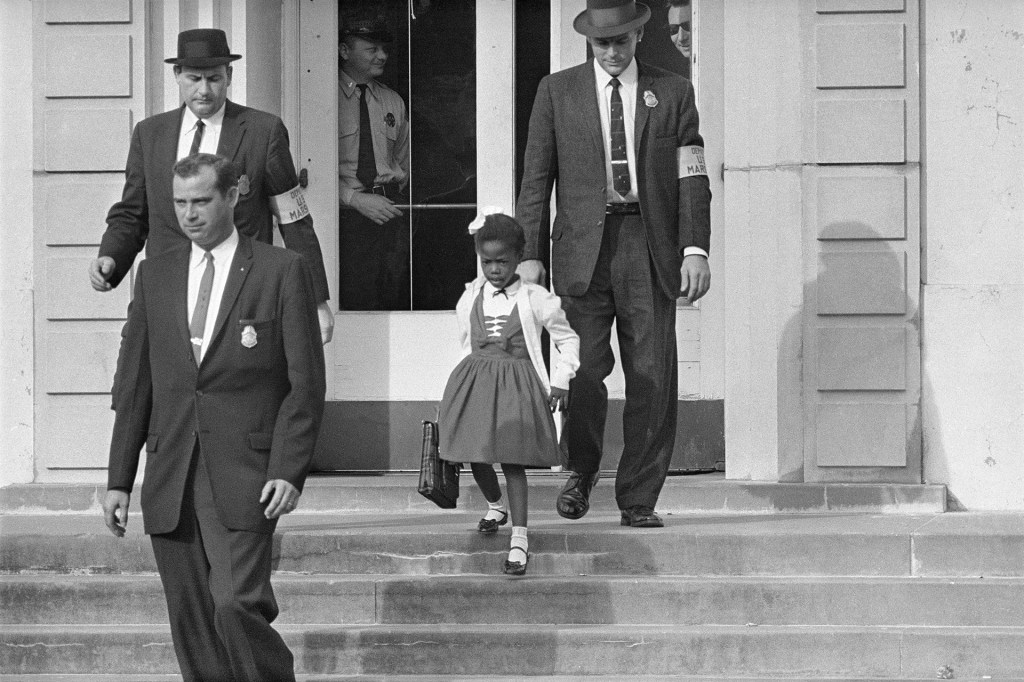Ruby Bridges

In 1960, Ruby Bridges (September 8, 1954—present) walked through the doors of William Frantz Elementary School, in New Orleans, Louisiana. By doing so, she became the first African-American student to attend an all-white elementary school in the Southern United States.
On November 14, 1960, Ruby Bridges became a symbol of the U.S. civil rights movement. She was just 6 years old. Her simple act of going to an all-white school marked the beginning of integration for U.S. public schools.
Bridges was born in Tylertown, Mississippi, on September 8, 1954. A few months before her birth, the Supreme Court—the nation’s highest court —had issued a ruling on five combined cases that would impact not only Bridges’s life, but also change the course of American history.
In Brown v. Board of Education of Topeka, Kansas, the prosecution wanted to end the idea of “separate but equal schools.” In many places in the U.S., black students and white students could not attend the same school. On May 17, 1954, the Supreme Court ruled that segregation in U.S. public schools was against the constitution. In his opinion, Chief Justice Earl Warren stated that “in the field of public education the doctrine Doctrine a teaching or belief (noun) The government was founded on a doctrine of equality. of ‘separate but equal’ has no place. Separate educational facilities are inherently Inherent part of the nature of a person or thing; inborn (adjective) The judge has an inherent sense of fairness. unequal . . .”
Although it was illegal to have segregated schools, some states—especially in the South—did not follow the ruling. The Supreme Court was aware of the resistance and took action. A year after the ruling, the court declared that the desegregation of public schools should advance with “all deliberate speed.” Five years later, little Ruby would become the first student to integrate Integrate to bring together (verb) The teams were integrated so that everyone could play. a Southern elementary school.
A Promising Student
When Bridges was 4, the family moved from Mississippi to New Orleans, Louisiana. Her parents hoped a new city would offer better job opportunities. Her father, Abon, found a job working as a gas station attendant and her mother, Lucille, worked nights to help support their growing family.
Bridges attended kindergarten in a segregated school in New Orleans. But in 1960, a federal court ordered that Louisiana desegregate Desegregate to eliminate segregation (verb) Eventually the city's schools desegregated and allowed all children to attend. all of its public schools. Bridges was a good student. She was chosen to be part of a small group of black students who would take an exam given by the school district. The exam determined which students would attend the all-white schools. Bridges was one of six black children who passed the exam. She enrolled in William Frantz Elementary School. It was just blocks from her home.
At first, Bridges’s father refused to enroll his daughter in the all-white school. He feared some would seek revenge on the family. However, her mother convinced him that it was the right decision. She believed their daughter would get a better education at an all-white school. Bridges’s parents were unable to read or write. On November 14, federal marshals escorted Bridges and her mother to her new school.
School of One
In a 1997 interview with PBS NewsHour, Bridges recalled preparing to leave for her new school. She remembered looking out the window of a car driven by a U.S. marshal. “Driving up, I could see the crowd,” she said, “but living in New Orleans, I actually thought it was Mardi Gras.”
The angry crowd chanted, “Two, four, six, eight, we don’t want to integrate.” They tried to block the entrance to the school. While Bridges and her mother sat in the principal’s office, hundreds of parents entered the school and removed their children from their classrooms. “They didn’t see a child,” Bridges later said in the PBS special series The African Americans. “They saw change and what they thought was being taken from them.”
The next day, Bridges was led past the screaming crowd and into the school by four marshals. When she arrived at her classroom, she found a teacher but no students. Her teacher, Barbara Henry, was a Boston, Massachusetts, native who had moved to the South hoping to help schools integrate. She was the only teacher willing to teach Bridges. “She would greet me, take me to my classroom, and it was just her and I,” said Bridges. Although Bridges and Henry remained in the classroom alone, neither missed a single day of school that year.
A Lasting Legacy
The following school year, Bridges attended second grade at William Frantz. This time, the crowds had disappeared, and her classroom was full of students. In 1963, she was immortalized in a now-iconic painting called The Problem We All Live With, by artist Norman Rockwell.
In 1999, Bridges established the Ruby Bridges Foundation to teach tolerance to students. The following year, she was made an honorary deputy federal marshal in Washington, D.C. “I am so proud to have received such an honor,” she said. “Deputy U.S. marshals are peacemakers and advocates of justice.”
In 2014—54 years after she attended her first day of school at William Frantz—a bronze statue of 6-year-old Ruby Bridges was unveiled in the school’s courtyard. “We need to honor the power of children,” she said at the ceremony. “We need to encourage them that they can do extraordinary things.”
Today, Bridges is an author, activist, and public speaker. She continues her work helping people learn to be more accepting of others.












